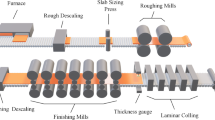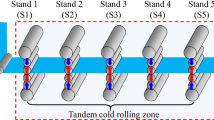Abstract
A novel intelligent control strategy based on machine learning (ML) and an optimal feed-forward control method are proposed to realize the high-precision prediction and precise control of slab front-end bending in hot rolling. By analyzing the mechanism of slab front-end bending, the factors influencing hot rolling slab front-end bending are analyzed by a simulation model, and the actuator efficiency model of slab front-end bending is established. Through exploring the genetic law of slab front-end bending, an optimization design for slab front-end bending control that combines bar feed-forward with pass feed-forward is presented. By comparing different ML methods, the XGBoost model is selected to establish a prediction model and is combined the proposed optimal control strategy to realize slab front-end bending control. The proposed control strategy has been successfully applied to industrial sites and achieved satisfactory results, which the proportion of the serious slab turn-up phenomenon has been reduced by 11.12%, and the proportion of bending values within 50 mm has increased by 18.56%. The product quality is significantly improved, and automatic control of slab front-end bending for hot rolling is realized.














Similar content being viewed by others
Data availability
The authors confirm that the data and material supporting the findings of this work are available within the article.
Code availability
The authors confirm that the code supporting the findings of this work are available within the article.
References
Anders D, Münker T, Artel, J Weinberg, K (2012) A dimensional analysis of front-end bending in plate rolling applications. J. Mater Process Tech. 212:1387–1398. https://doi.org/10.1016/j.jmatprotec.2012.02.005
Hwang YM, Tzou GY (1993) An analytical approach to asymmetrical cold strip rolling using the slab method. Journal of Engineering and Performance 2:597–606. https://doi.org/10.1007/bf02661746
Kiefer T, Kugi A (2008) An analytical approach for modelling asymmetrical hot rolling of heavy plates. Mathematical and Computer Modelling of Dynamical Systems 14(3):249–267 http://www.tandfonline.com/loi/nmcm20
Pawelski H (2000) Comparison of methods for calculating the influence of asymmetry in strip and plate rolling. Steel research int. 71:490–496. https://doi.org/10.1002/srin.200005720
Philipp M, Schwenzfeier W, Fischer FD, Wödlinger R, Fischer C (2007) Front end bending in plate rolling influenced by circumferential speed mismatch and geometry. J. Mater Process Tech. 184(1-3):224–232. https://doi.org/10.1016/j.jmatprotec.2006.11.027
Farhat-Nia F, Salimi M, Movahhedy MR (2006) Elasto-plastic finite element simulation of asymmetrical plate rolling using an ALE approach. J. Mater Process Tech. 177:525–529. https://doi.org/10.1016/j.jmatprotec.2006.04.075
Jeswiet J, Greene PG (1998) Experimental measurement of curl in rolling. J. Mater Process Tech. 84:202–209. https://doi.org/10.1007/978-1-349-13796-1_54
Salimia M, Sassani F (2002) Modified slab analysis of asymmetrical plate rolling. International Journal of Mechanical Sciences 44:1999–2023. https://doi.org/10.1016/s0020-7403(02)00043-7
Byon SM, Lee Y (2013) An in-line model for predicting front end bending in hot plate rolling and its experimental verification. Proceedings of the Institution of Mechanical Engineers 227(8). https://doi.org/10.1007/s00170-022-08825-w
Park JS, Na DH, Yang Z, Hur SM, Chung SH, Lee Y (2016) Application of neural networks to minimize front end bending of material in plate rolling process. Proceedings of the Institution of Mechanical Engineers 230(4). https://doi.org/10.1177/0954405415593052
Ding JG, He YHC, Kong LP, Peng W (2021) Camber prediction based on fusion method with mechanism model and machine learning in plate rolling. ISIJ Int. 61(10):2540–2551. https://doi.org/10.2355/isijinternational.ISIJINT-2020-357
Xu D, Yang Q, Wang XC, Wang HB, Zhang W, Liu JT (2020) Application of Takagi–Sugeno fuzzy model for slab camber control in a hot strip rougher mill. Ironmaking & Steelmaking 47:623–631. https://doi.org/10.1080/03019233.2020.1788883
Deng JF, Sun J, Peng W, Hu YH, Zhang DH (2019) Application of neural networks for predicting hot-rolled strip crown. Appl. Soft Comput. 78:119–131. https://doi.org/10.1016/j.asoc.2019.02.030
Song LB, Xu D, Wang XC, Yang Q, Ji YF (2022) Application of machine learning to predict and diagnose for hot-rolled strip crown. Int. J. Adv. Manuf. Technol. 120:881–890. https://doi.org/10.1007/s00170-022-08825-w
Alaei H, Salimi M, Nourani A (2016) Online prediction of work rolls thermal expansion in a hot rolling process by a neural network. Int J Adv. Manuf. Technol. 85:1769–1777. https://doi.org/10.1007/s00170-015-8073-3
Lu X, Sun J, Song ZX, Li GT, Wang ZH, Hu JY, Wang QL, Zhang DH (2020) Prediction and analysis of cold rolling mill vibration based on a data-driven method. Appl. Soft Comput. 96:106706. https://doi.org/10.1016/j.asoc.2020.106706
Liu X, Athanasiou CE, Padture NP, Sheldon BW, Gao HJ (2020) A machine learning approach to fracture mechanics problems. Acta Materialia 190:105–112. https://doi.org/10.1016/j.actamat.2020.03.016
Shen CG, Wang CC, Wei XL, Li Y, Zwaag S, Xu W (2019) Physical metallurgy-guided machine learning and artificial intelligent design of ultrahigh-strength stainless steel. Acta Materialia 179:201–214. https://doi.org/10.1016/j.actamat.2019.08.033
Liu CJ, Ding WF, Li Z, Yang CY (2016) Prediction of high-speed grinding temperature of titanium matrix composites using BP neural network based on PSO algorithm. Int. J. Adv. Manuf. Technol. 89:1–9. https://doi.org/10.1007/s00170-016-9267-z
Mendez GM, Castillo O, Colas R, Moreno H (2014) Finishing mill strip gage setup and control by interval type-1 non-singleton type-2 fuzzy logic systems. Appl. Soft Comput. 24(5):900–911. https://doi.org/10.1016/j.asoc.2014.08.052
Wang PF, Yan P, Liu HM, Zhang (2013) DH Actuator efficiency adaptive flatness control model and its application in 1250 mm reversible cold strip mill. J. Iron Steel Res. Int. 20:13–20. https://doi.org/10.13228/j.boyuan.issn1006-706x.2013.06.002
Wold S, Sjöström M, Eriksson L (2001) PLS-regression: a basic tool of chemometrics. Chemometrics & Intelligent Laboratory Systems 58(2):109–130. https://doi.org/10.1016/s0169-7439(01)00155-1
Peng KX, Zhang K, You B, Dong J (2015) Quality-related prediction and monitoring of multi-mode processes using multiple PLS with application to an industrial hot strip mill. Neurocomputing 168:1094–1103. https://doi.org/10.1016/j.neucom.2015.05.014
Takagi T, Sugeno M (1985) Fuzzy identification of systems and its applications to modeling and control. IEEE Transactions on Systems, Man, and Cybernetics 15(1):116–132. https://doi.org/10.1109/TSMC.1985.6313399
Barrios JA, Villanueva C, Cavazos A, Colas R (2016) Fuzzy C-means rule generation for fuzzy entry temperature prediction in a hot strip mill. J. Iron Steel Res. Int. 23(2):116–123. https://doi.org/10.1016/S1006-706X(16)30022-X
Zhang DW, Ji M, Yang J, Zhang Y, Xie FD (2014) A novel cluster validity index for fuzzy clustering based on bipartite modularity. Fuzzy Sets & Systems 253(10):122–137. https://doi.org/10.1016/j.fss.2013.12.013
Vapnik VN (1998) Statistical Learning Theory. Wiley, New York ISBN: 978-0-471-03003-4
Wang ZH, Liu YM, Gong DY, Zhang DH (2018) A new predictive model for strip crown in hot rolling by using the hybrid AMPSO-SVR-Based approach. Steel research int. 89(7):0003. https://doi.org/10.1002/srin.20180
Vidyasagar M (2015) Statistical learning theory and randomized algorithms for control. Control Systems IEEE 18(6):69–85. https://doi.org/10.1109/37.736014
Chen T, Guestrin C (2016) XGBoost: a scalable tree boosting system, in: Proceedings of the 22nd ACM SIGKDD International Conference on Knowledge Discovery and Data Mining. ACM. 785–794. https://doi.org/10.1145/2939672.2939785
Nguyen H, Bui XN, Bui HB, Cuong DT (2019) Developing an XGBoost model to predict blast-induced peak particle velocity in an open-pit mine: a case study. Acta Geophys 67:477–490. https://doi.org/10.1007/s11600-019-00268-4
Zhang D, Qian L, Mao B, Huang C, Huang B, Si Y (2018) A data-driven design for fault detection of wind turbines using random forests and XGBoost. IEEE Access 6:21020–21031. https://doi.org/10.1109/ACCESS.2018.2818678
Ahmadizar F, Soltanian K, AkhlaghianTab F, Tsoulos I (2015) Artificial neural network development by means of a novel combination of grammatical evolution and genetic algorithm. Eng Appl Artif Intell 39:1–13. https://doi.org/10.1016/j.engappai.2014.11.003
Funding
This work is financially supported by the National Key Research and Development Plan (Grant No. 2020YFB1713600); the National Natural Science Foundation of China (Grant No. 51975043); and the Fundamental Research Funds for the Central Universities (Grant No. FRF-TP-20-105A1).
Author information
Authors and Affiliations
Contributions
Lebao Song: Writing, original draft; software. Dong Xu: Conceptualization, data validation. Chengyun Wang: Methodology. Hainan He: Software, visualization. Xiaochen Wang: Writing—review and editing. Hui Li: Resources, investigation. Haijun Yu: Investigation, data validation. Quan Yang: Supervision.
Corresponding author
Ethics declarations
Ethics approval and consent to participate
The article follows the guidelines of the Committee on Publication Ethics (COPE) and involves no studies on human or animal subjects.
Consent for publication
This work is approved by all authors for publication.
Conflict of interest
The authors declare no competing interests.
Additional information
Publisher’s note
Springer Nature remains neutral with regard to jurisdictional claims in published maps and institutional affiliations.
Rights and permissions
Springer Nature or its licensor (e.g. a society or other partner) holds exclusive rights to this article under a publishing agreement with the author(s) or other rightsholder(s); author self-archiving of the accepted manuscript version of this article is solely governed by the terms of such publishing agreement and applicable law.
About this article
Cite this article
Song, L., Xu, D., Wang, C. et al. A novel intelligent method for slab front-end bending control in hot rolling. Int J Adv Manuf Technol 126, 4199–4212 (2023). https://doi.org/10.1007/s00170-023-11367-4
Received:
Accepted:
Published:
Issue Date:
DOI: https://doi.org/10.1007/s00170-023-11367-4




